Four-Year Monitoring Study of Shallow Landslide Hazards Based on Hydrological Measurements in a Weathered Granite Soil Slope in South Korea
Abstract
:1. Introduction
2. Landslides, Monitoring Station, and Sensors
2.1. Physical Setting
2.2. Landslides in Mt. Songnisan National Park, South Korea
2.3. Monitoring Station and Sensors
3. Methods and Data
3.1. Theoretical Scheme of Shallow Landslide Hazard Monitoring
3.2. Geotechnical and Unsaturated Properties of Soil
3.3. Monitored Source Data: Rainfall and VWC
4. Results and Discussion
4.1. Estimations of Matric Suction and Suction Stress
4.2. Evaluation of Shallow Landslide Hazards of Unsaturated Soil Slope
4.3. Future Study: Validating Continuous Rainfall as an Index of Slope Moisture Conditions
4.4. Cross-Sectional Conceptual Framework and Discussion of Limitations
5. Conclusions
- The monitoring results of VWC: it seemed that the slope had its own unique minimum moisture level that was retained and no longer drained during non-rainfall periods. Such a unique minimum moisture level of the slope corresponded to an effective degree of saturation of 0.2. The estimated matric suction and suction stress at the unique minimum moisture level were 30 kPa and 7.5 kPa, respectively. However, entering the rainy season in summer, further decreases in the moisture level less than the unique minimum were evident due to evapotranspiration effects. On the other hand, the drainage effects dominantly governed relatively instant and sharp reductions back to the unique minimum moisture level in the increased degrees of saturation in the slope induced by rainfall infiltration.
- Different tendencies in the hydrological responses of the slope to rainfall existed between the 0.5 m and 1.0 m soil depths. The deeper location was less sensitive to rainfall and displayed less dispersion of the soil moisture level.
- The soil moisture levels tended to increase along the downslope direction. This tendency faded as the depth increased. Accordingly, the magnitude of suction stress in unsaturated soils tended to decrease along the downslope direction. This is because infiltrated rainwater flows downslope and tends to converge and accumulate in the lower sections of the slopes. Such hydro-mechanical processes may be one of the main reasons that translational slides are often observed in retrogressive slope failure types.
- The calculated FOS values in the slope ranged from 4.3 to 5.5 at 0.5 m, and from 2.6 to 3.3 at 1.0 m. At the shallower depth, larger dispersions in the FOS were observed with higher FOSs in more upslope locations. The slope responded more sensitively to external factors, such as rainfall and temperature, at shallower depths.
- Considering field uncertainties, a probable scenario with more hazardous slope conditions could be presumed, where cohesion effects were negligible and the slope was inclined over 30°. In this scenario, the minimum FOS decreased from 2.6 to less than 1.0, namely, the limit of slope stability.
- Continuous rainfall, which has been previously proposed as an indicator of slope moisture conditions that could potentially lead to the initiation of shallow landslides, successfully represented the matric suction (or moisture level) condition at the 1.0 m depth in the lower slope, whereas this was not the case for the upper and middle slopes. Presuming no installation-induced errors, this is perhaps due to the downslope drainage processes being more rapid than the vertical flows of subsurface water.
- Future analyses of monitoring data collected from various sites in other geological conditions in Korea are expected to numerically deduce the critical amount of continuous rainfall, which is a minimum requirement to enter a phase of slope instability for each slope. In this presumption, it is desirable in the future to establish an integrated shallow landslide hazard evaluation strategy that utilizes in parallel a monitoring-based real-time evaluation method and the numerically determined critical quantity of continuous rainfall to provide validated early warning information at a single slope and at a regional scale.
- This study, which highlights a hydrological measurement-based shallow landslide monitoring framework, possesses several limitations: the high cost, the fact that it is not applicable for regional scales or forecasting, and the inability of the framework to derive positive pore-water pressures.
Supplementary Materials
Author Contributions
Funding
Institutional Review Board Statement
Informed Consent Statement
Data Availability Statement
Conflicts of Interest
References
- Froude, M.J.; Petley, D. Global fatal landslide occurrence from 2004 to 2016. Nat. Hazards Earth Syst. Sci. 2018, 18, 2161–2181. [Google Scholar] [CrossRef] [Green Version]
- Pachauri, R.K.; Allen, M.R.; Barros, V.R.; Broome, J.; Cramer, W.; Christ, R.; Church, J.A.; Clarke, L.; Dahe, Q.; Dasgupta, P.; et al. Climate Change 2014: Synthesis Report. Contribution of Working Groups I, II and III to the Fifth Assessment Report of the Intergovernmental Panel on Climate Change; IPCC: Geneva, Switzerland, 2014; p. 151. [Google Scholar]
- Chhorn, C.R.; Kim, G.; Yune, C.Y.; Lee, S.W. Analysis of the magnitude of debris flows in Korea. Nat. Hazards Rev. ASCE 2015, 16, 04015001. [Google Scholar] [CrossRef]
- Song, Y.-S.; Chae, B.-G.; Kim, K.-S.; Park, J.-Y.; Oh, H.-J.; Jeong, S.-W. A Landslide Monitoring System for Natural Terrain in Korea: Development and Application in Hazard Evaluations. Sensors 2021, 21, 3040. [Google Scholar] [CrossRef] [PubMed]
- Locat, J.; Lee, H.J. Submarine landslides: Advances and challenges. Can. Geotech. J. 2002, 39, 193–212. [Google Scholar] [CrossRef]
- Intrieri, E.; Gigli, G.; Mugnai, F.; Fanti, R.; Casagli, N. Design and implementation of a landslide early warning system. Eng. Geol. 2012, 147–148, 124–136. [Google Scholar] [CrossRef] [Green Version]
- Pecoraro, G.; Clvello, M.; Piciullo, L. Monitoring strategies for local landslide early warning systems. Landslides 2019, 16, 213–231. [Google Scholar] [CrossRef]
- Savvaidis, P.D. Existing Landslide Monitoring Systems and Techniques; School of Rural and Surveying Engineering, The Aristotle University of Thessaloniki: Thessaloniki, Greece, 2003; pp. 242–258. [Google Scholar]
- Travelletti, J.; Delacourt, C.; Allemand, P.; Malet, J.P.; Schmittbuhl, J.; Toussaint, R.; Bastard, M. Correlation of multi-temporal ground-based optical images for landslide monitoring: Application, potential and limitations. ISPRS J. Photo. Rem. Sens. 2012, 70, 39–55. [Google Scholar] [CrossRef] [Green Version]
- Uhlemann, S.; Smith, A.; Chambers, J.; Dixon, N.; Dijkstra, T.; Haslam, E.; Meldrum, P.; Merritt, A.; Gunn, D.; Mackay, J. Assessment of ground-based monitoring techniques applied to landslide investigations. Geomorphology 2016, 253, 438–451. [Google Scholar] [CrossRef] [Green Version]
- Moore, J.R.; Gischig, V.; Button, E.; Loew, S. Rockslide deformation monitoring with fiber optic strain sensors. Nat. Hazards Earth Syst. Sci. 2010, 10, 191–201. [Google Scholar] [CrossRef]
- Mainsant, G.; Larose, E.; Bronnimann, C.; Jongmans, D.; Michoud, C.; Jaboyedoff, M. Ambient seismic noise monitoring of a clay landslide: Toward failure prediction. J. Geophys. Res. 2012, 117, F01030. [Google Scholar] [CrossRef] [Green Version]
- Fukuzono, T. A new method for predicting the failure time of a slope. In Proceedings of the IVth International Conference Field Workshop on Landslides, Tokyo, Japan, 23–31 August 1985; pp. 145–1050. [Google Scholar]
- Malet, J.P.; Maquaire, O.; Calais, E. The use of global positioning system techniques for the continuous monitoring of landslides: Application to the Super-Sauze earthflow (Alpes-de-Haute-Provence, France). Geomorphology 2002, 43, 33–54. [Google Scholar] [CrossRef] [Green Version]
- Calvello, M.; Cascini, L.; Sorbino, G. A numerical procedure for predicting rainfall-induced movements of active landslides along pre-existing slip surfaces. Intl. J. Num. Anal. Meth. Geomech. 2008, 32, 327–351. [Google Scholar] [CrossRef]
- Lim, T.T.; Rahardjo, H.; Chang, M.F.; Fredlund, D.G. Effect of rainfall on matric suctions in a residual soil slope. Can. Geotech. J. 1996, 33, 618–628. [Google Scholar] [CrossRef]
- Ng, C.W.W.; Zhan, L.T.; Bao, C.G.; Fredlund, D.G.; Gong, B.W. Performance of an unsaturated expansive soil slope subjected to artificial rainfall infiltration. Geotechniques 2003, 53, 143–157. [Google Scholar] [CrossRef]
- Springman, S.M.; Jommi, C.; Teysseire, P. Instabilities on moraine slopes induced by loss of suction: A case history. Geotechniques 2003, 53, 3–10. [Google Scholar] [CrossRef]
- Godt, J.W.; Baum, R.L.; Lu, N. Landsliding in partially saturated materials. Geophys. Res. Let. 2009, 36, L02403. [Google Scholar] [CrossRef]
- Damiano, E.; Olivares, L.; Picarelli, L. Steep-slope monitoring in unsaturated pyroclastic soils. Eng. Geol. 2012, 137–138, 1–12. [Google Scholar] [CrossRef]
- Bordoni, M.; Meisina, C.; Valentino, R.; Lu, N.; Bittelli, M.; Chersich, S. Hydrological factors affecting rainfall-induced shallow landslides: From the field monitoring to a simplified slope stability analysis. Eng. Geol. 2015, 193, 19–37. [Google Scholar] [CrossRef]
- Lu, N.; Likos, W.J. Suction stress characteristic curve for unsaturated soil. J. Geotech. Geoenviron. Eng. 2006, 132, 131–142. [Google Scholar] [CrossRef] [Green Version]
- Korean Soil Information System. Available online: http://soil.rda.go.kr/eng/index.jsp (accessed on 16 July 2021).
- Michoud, C.; Bazin, S.; Blikra, L.H.; Derron, M.H.; Jaboyedoff, M. Experiences from site-specific landslide early warning systems. Nat. Hazards Earth Syst. Sci. 2013, 13, 2659–2673. [Google Scholar] [CrossRef] [Green Version]
- Kim, K.S.; Song, Y.S. Geometrical and geotechnical characteristics of landslides in Korea under various geological conditions. J. Mt. Sci. 2015, 12, 1267–1280. [Google Scholar] [CrossRef]
- Skempton, A.W.; DeLory, F.A. Stability of natural slopes in London clay. Int. Conf. Soil Mech. 1957, 2, 378–381. [Google Scholar]
- Lu, N.; Godt, J. Infinite slope stability under steady unsaturated seepage conditions. Water Resour. Res. 2008, 44. [Google Scholar] [CrossRef]
- Giuseppe, F.; Simoni, S.; Godt, J.W.; Lu, N.; Rigon, R. Geomorphological control on variably saturated hillslope hydrology and slope instability. Water Resour. Res. 2016, 52, 4590–4607. [Google Scholar] [CrossRef] [Green Version]
- Song, Y.S.; Chae, B.G.; Lee, J. A method for evaluating the stability of an unsaturated slope in natural terrain during rainfall. Eng. Geol. 2016, 210, 84–92. [Google Scholar] [CrossRef]
- Van Genuchten, M.T. A Closed-form Equation for Predicting the Hydraulic Conductivity of Unsaturated Soils. Soil Sci. Soc. Am. J. 1980, 44, 892–898. [Google Scholar] [CrossRef] [Green Version]
- Lu, N.; Godt, J.W.; Wu, D.T. A closed-form equation for effective stress in unsaturated soil. Water Resour. Res. 2010, 46. [Google Scholar] [CrossRef]
- Song, Y.S.; Hwang, W.K.; Jung, S.J.; Kim, T.H. A comparative study of suction stress between sand and silt under unsaturated conditions. Eng. Geol. 2012, 124, 90–97. [Google Scholar] [CrossRef]
- Wayllace, A.; Lu, N. A transient water release and imbibitions method for rapidly measuring wetting and drying soil water retention and hydraulic conductivity functions. Geotech. Test. J. 2012, 35, 103–117. [Google Scholar]
- Park, J.Y.; Song, Y.S. Laboratory Experiment and Numerical Analysis on the Precursory Hydraulic Process of Rainfall-Induced Slope Failure. Adv. Civ. Eng. 2020, 2020, 2717356. [Google Scholar] [CrossRef]
- Lu, N. Is matric suction a stress variable? J. Geotech. Geoenviron. Eng. 2008, 134, 899–905. [Google Scholar] [CrossRef]
- Park, J.Y.; Lee, S.R.; Oh, S.; Lee, J.H.; Jeon, J.S.; Song, Y.S.; Park, H.S. Critical continuous rainfall map for forecasting shallow landslide initiations in Busan, Korea. Water 2020, 12, 2404. [Google Scholar] [CrossRef]
- Baum, R.L.; Godt, J.W.; Savage, W.Z. Estimating the timing and location of shallow rainfall-induced landslides using a model for transient, unsaturated infiltration. J. Geophys. Res. Earth Surf. 2010, 115, F3. [Google Scholar] [CrossRef]
- Chen, P.; Lu, N.; Formetta, G.; Godt, J.W.; Wayllace, A. Tropical storm-induced landslide potential using combined field monitoring and numerical modeling. J. Geotech. Geoenviron. Eng. 2018, 144, 05018002. [Google Scholar] [CrossRef]
- Lombardo, L.; Mai, P.M. Presenting logistic regression-based landslide susceptibility results. Eng. Geol. 2018, 244, 14–24. [Google Scholar] [CrossRef]

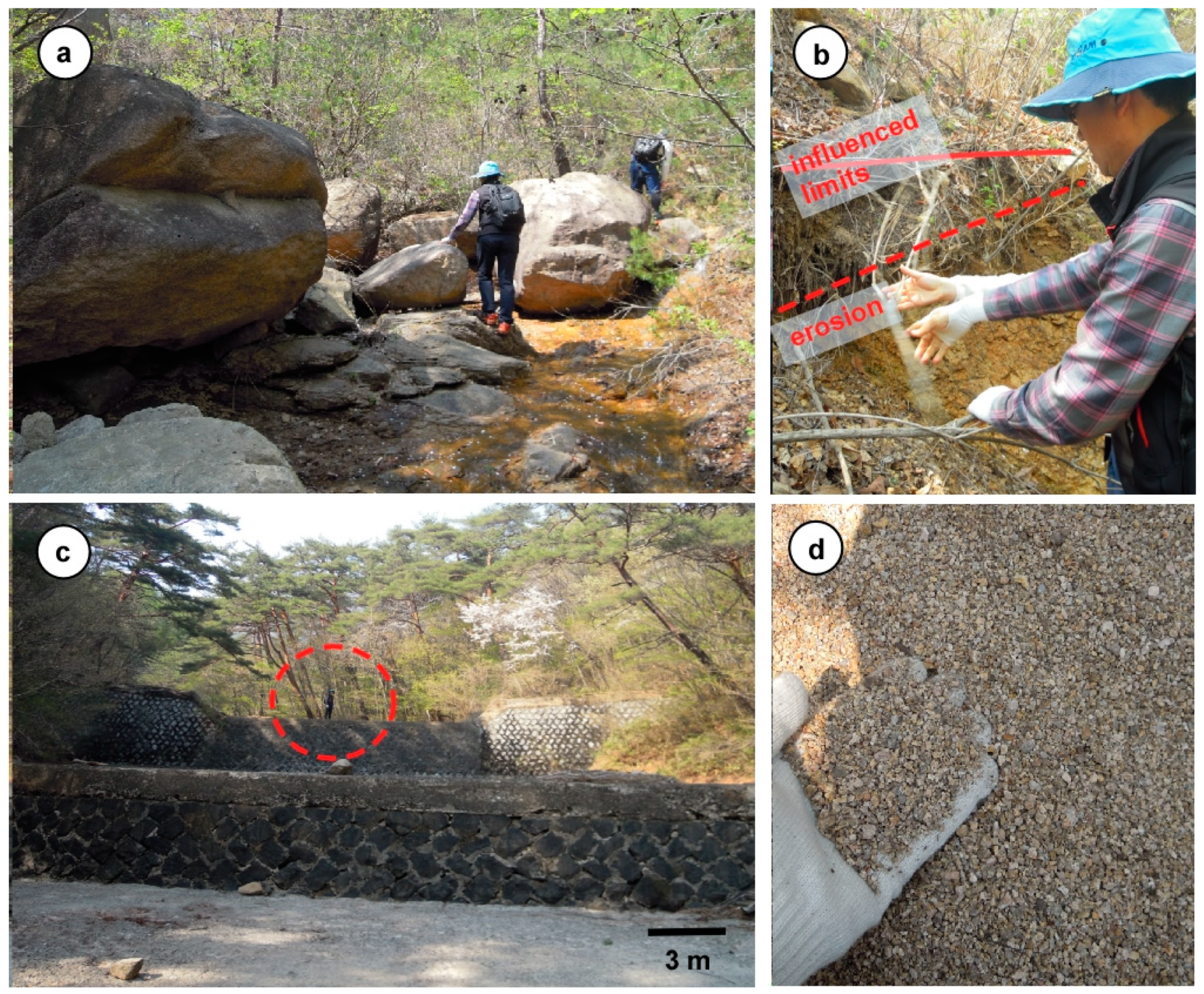
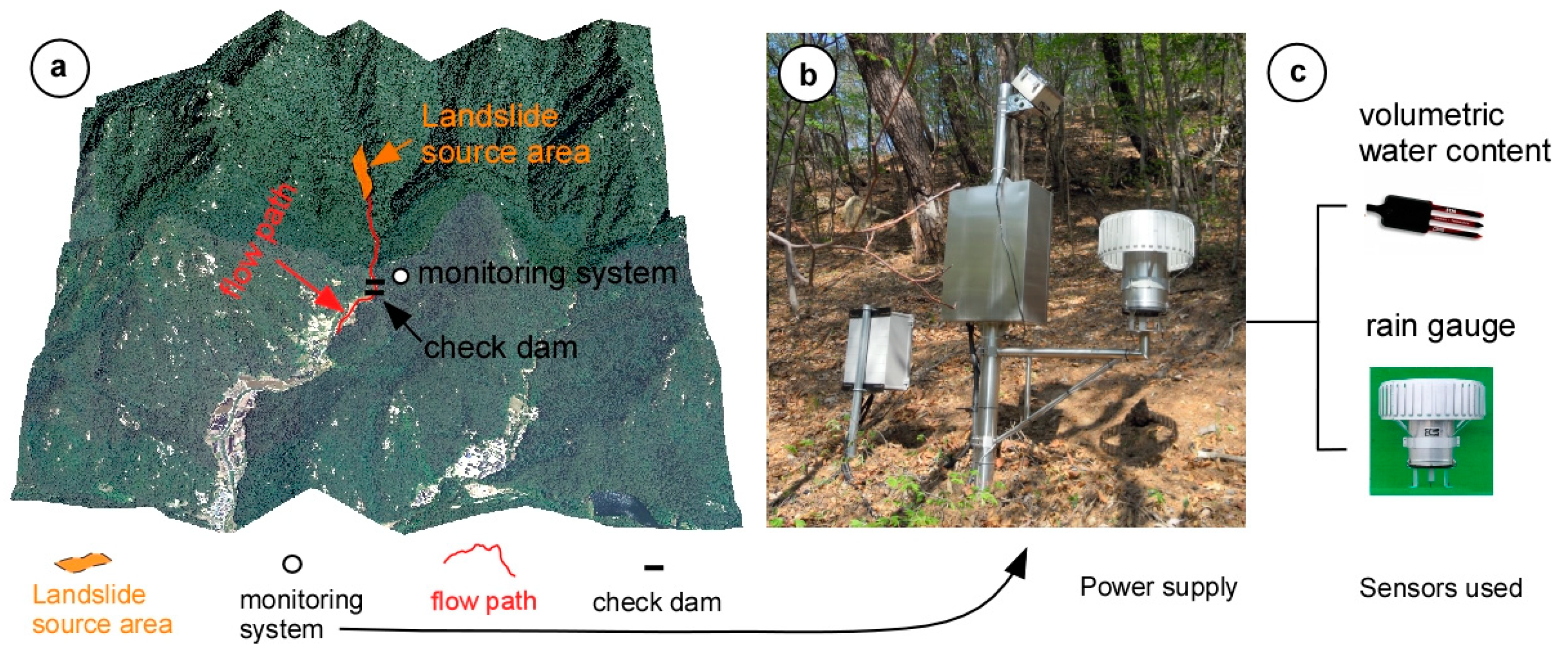
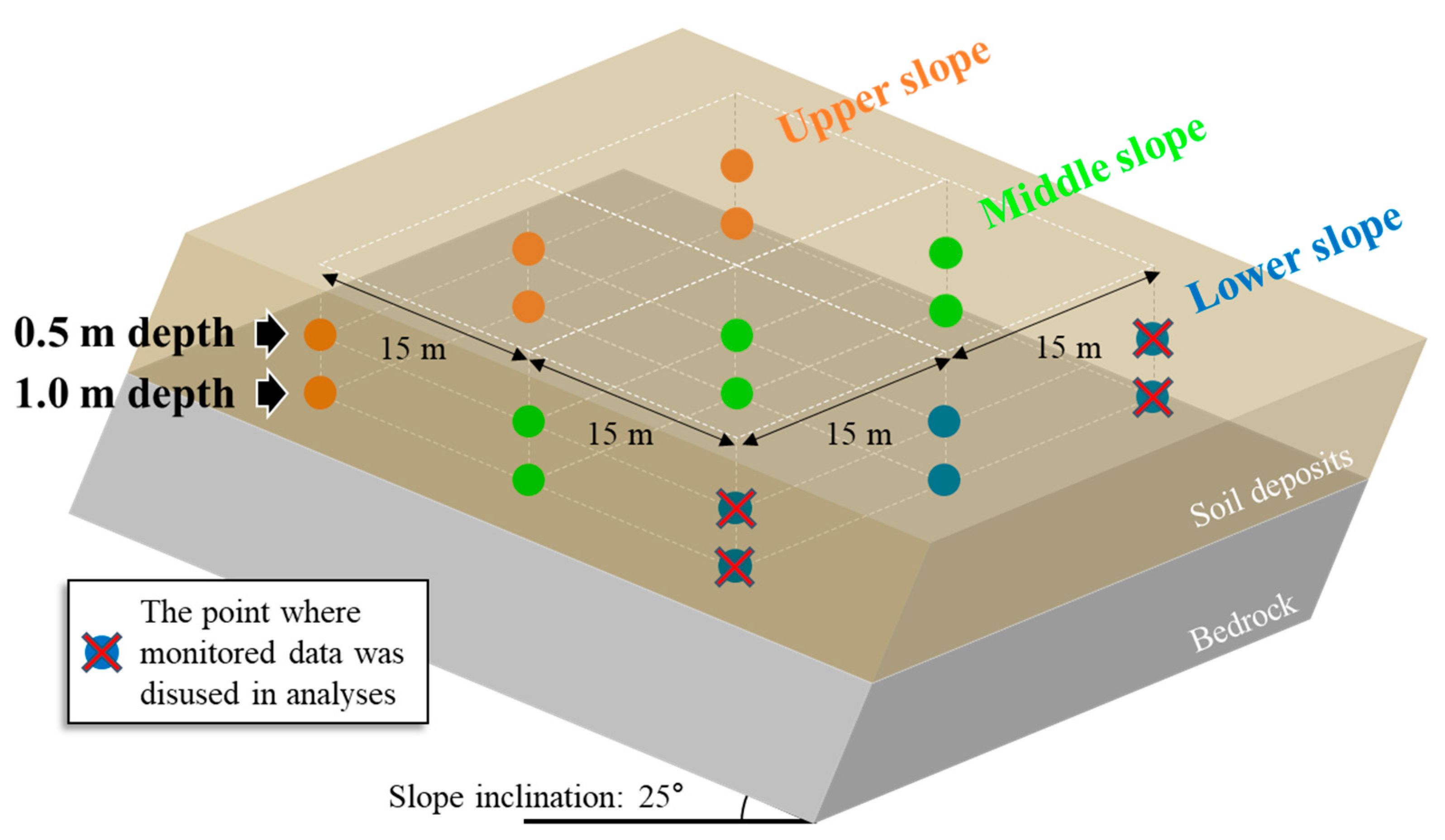
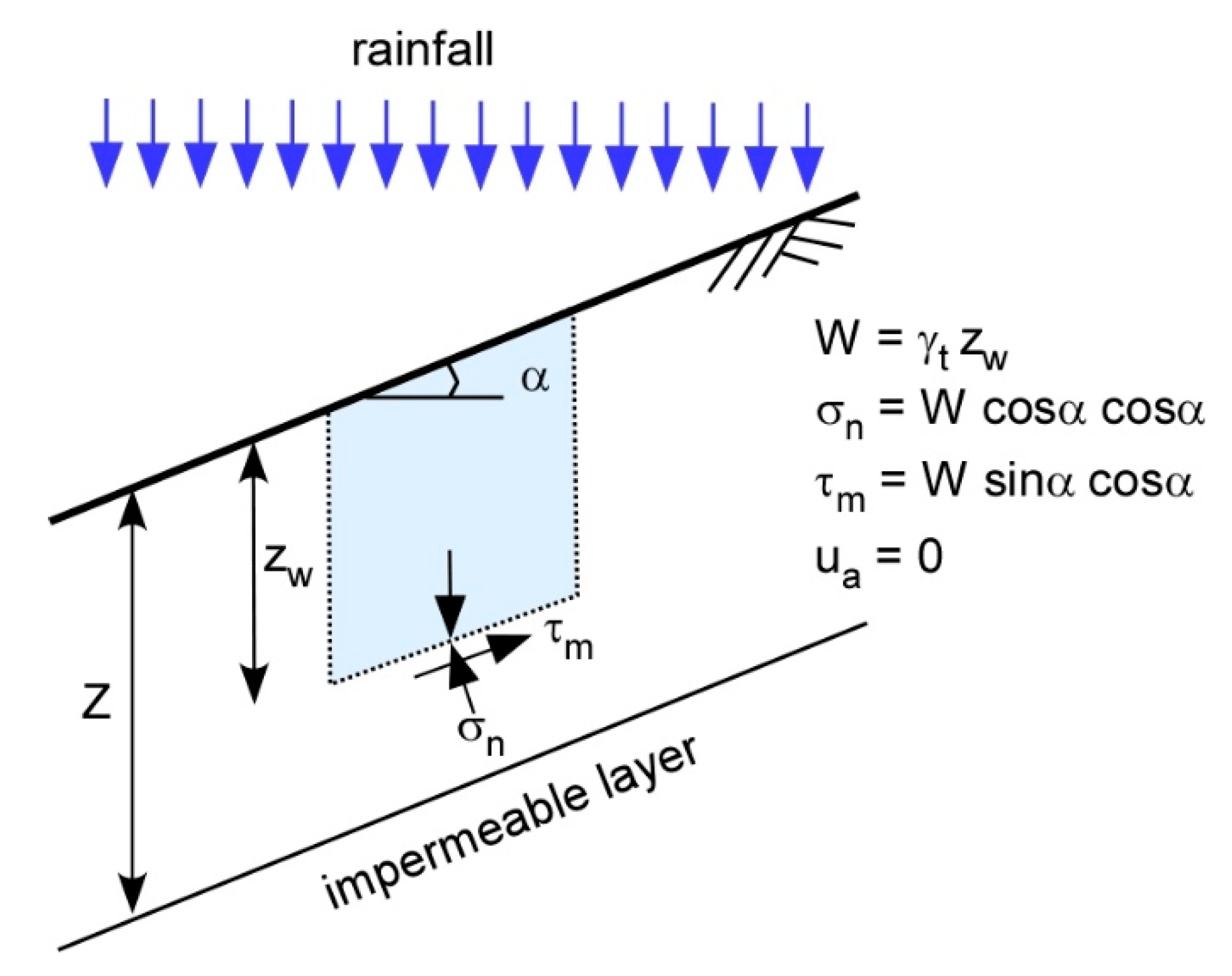
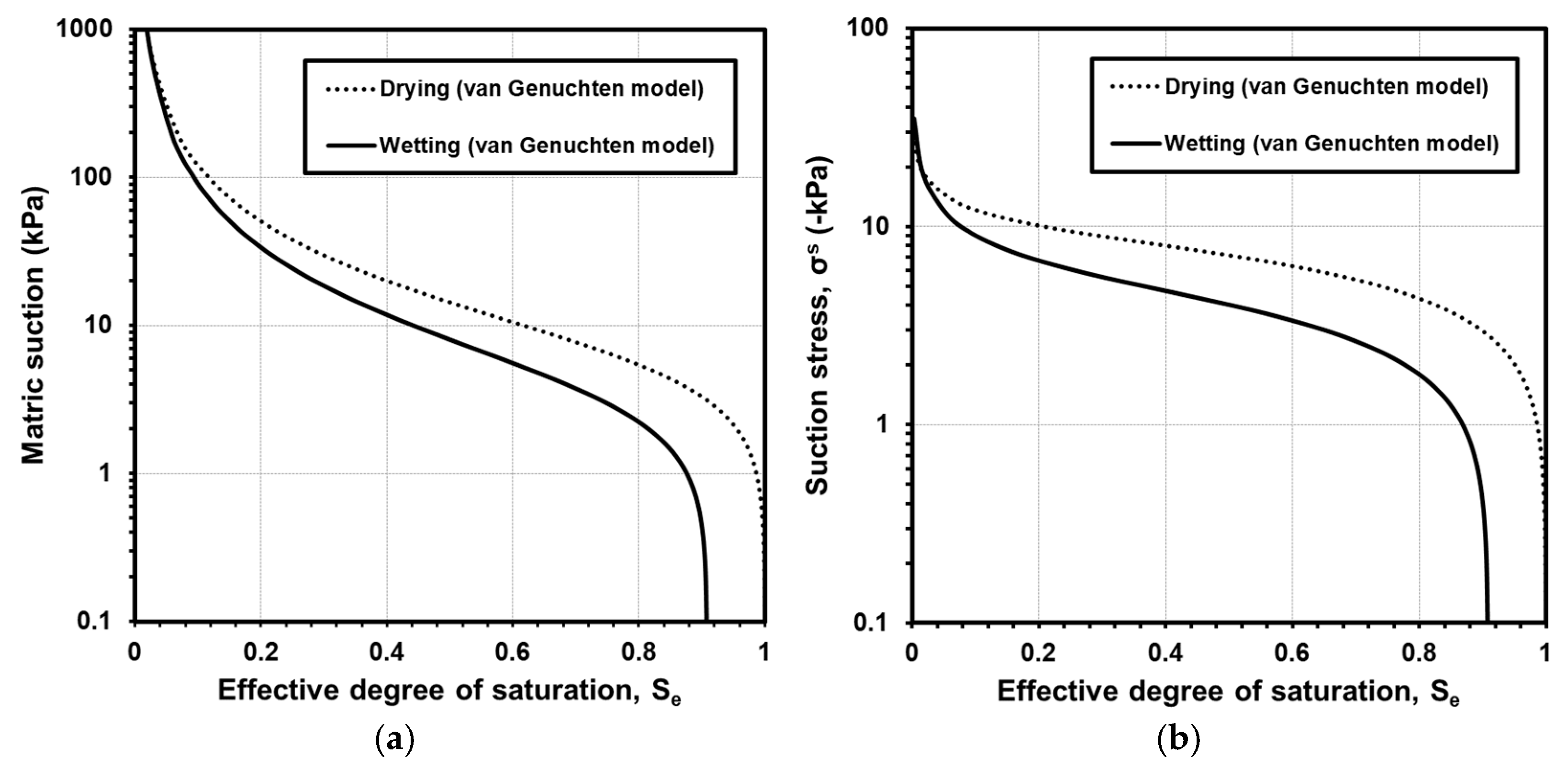
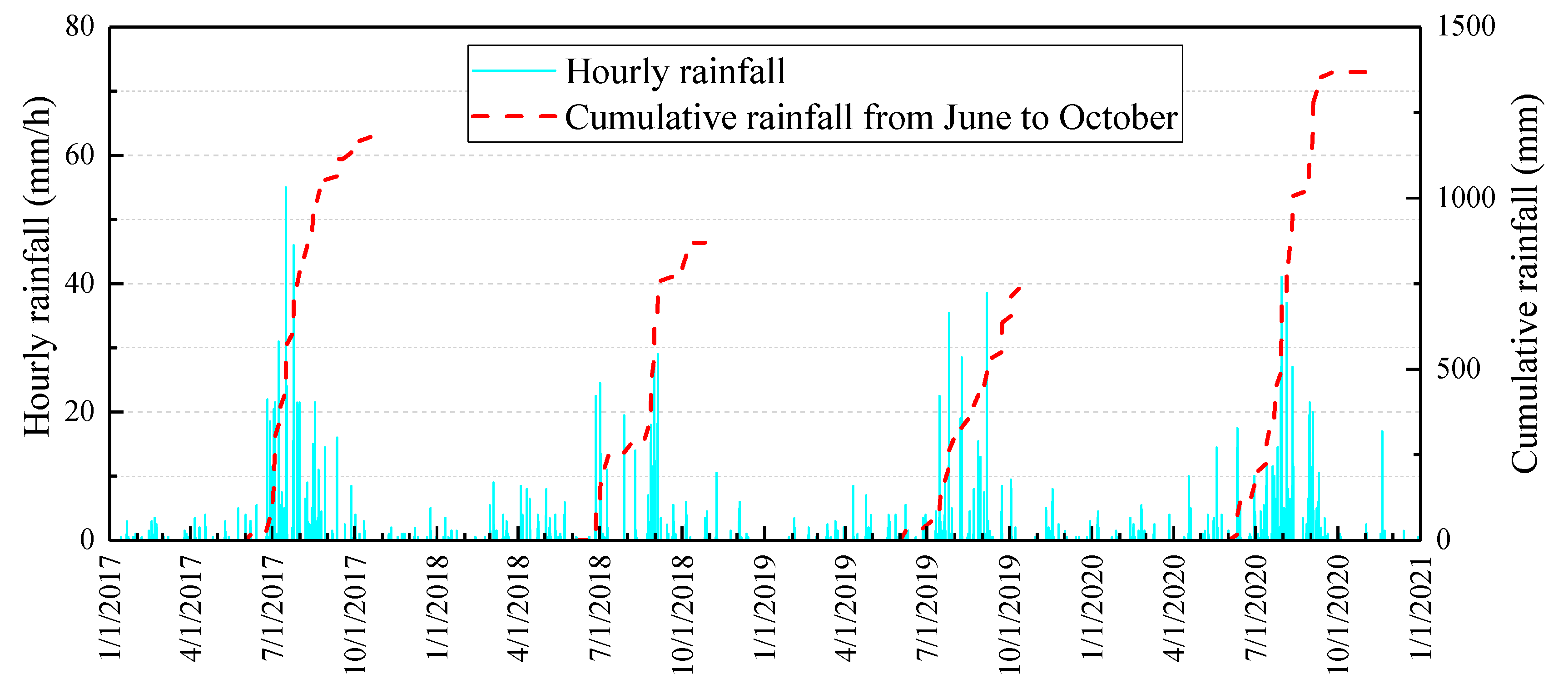
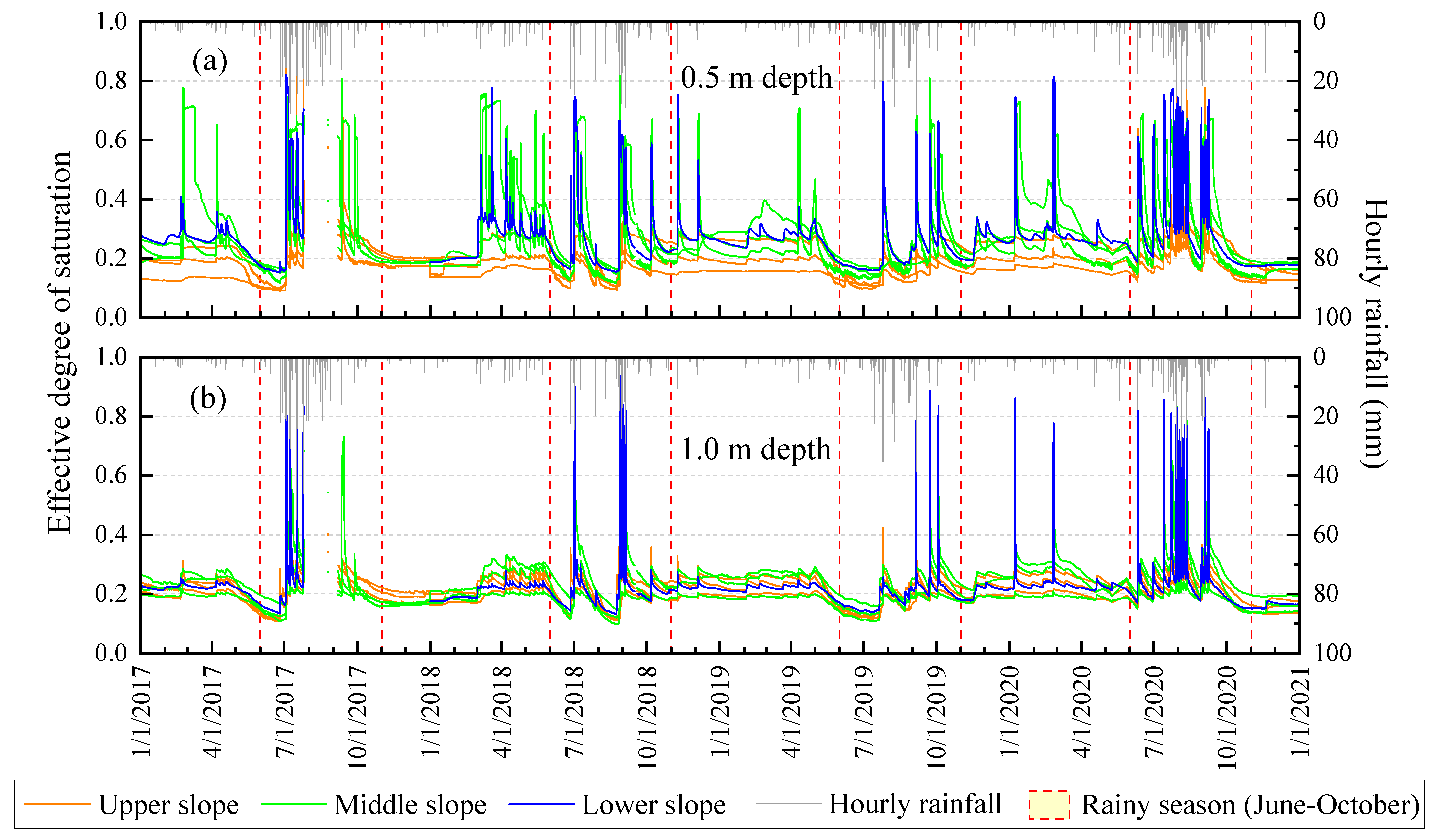
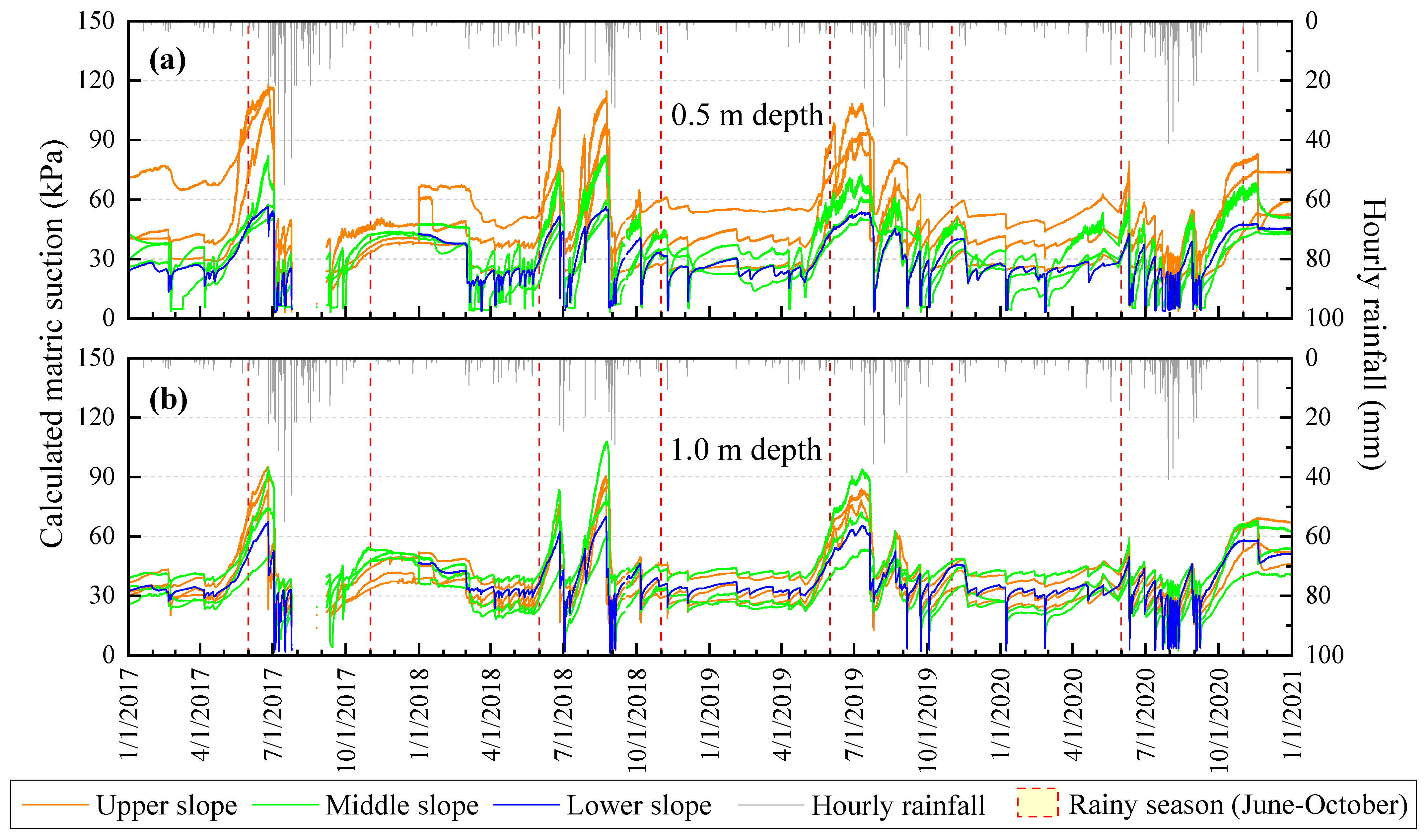
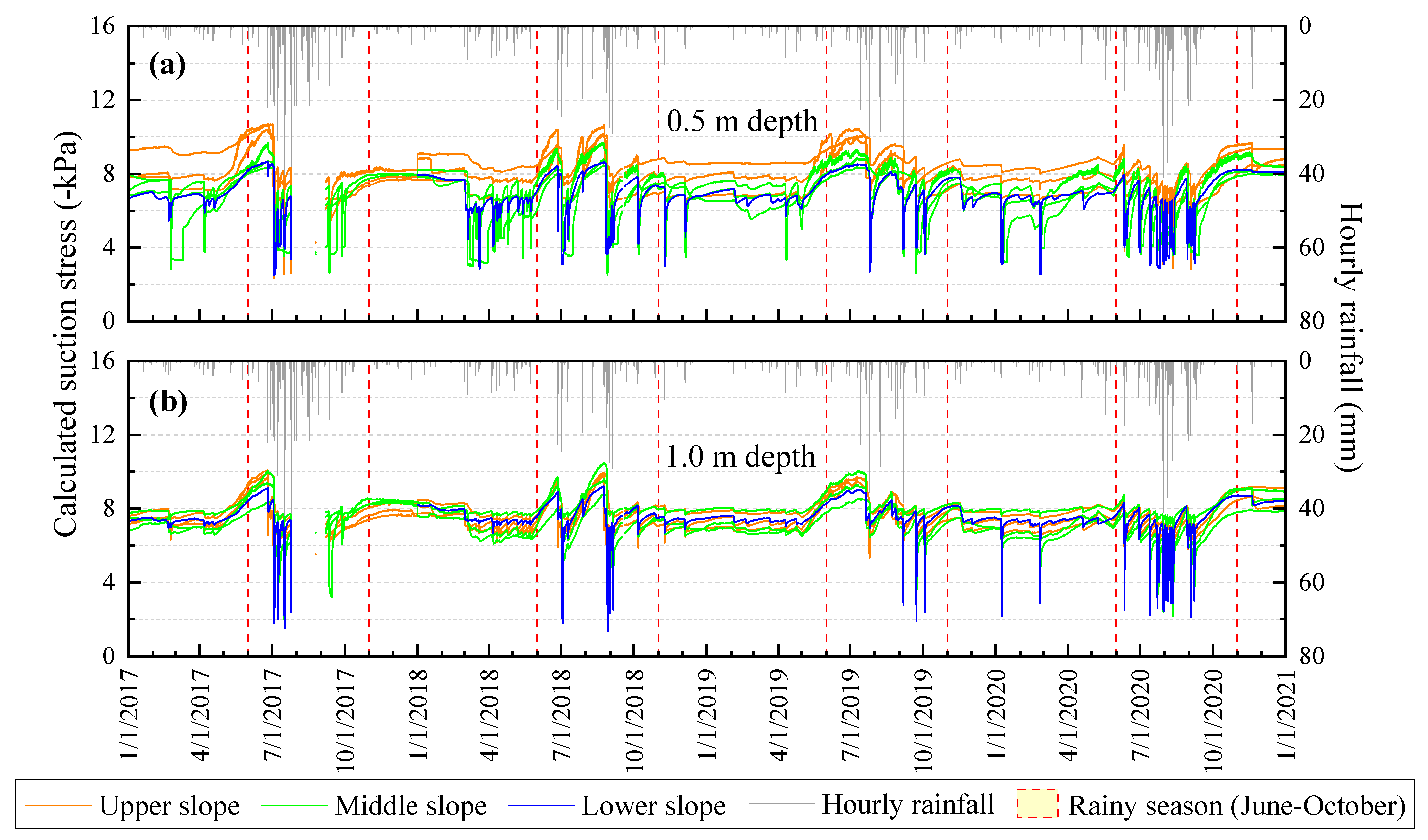
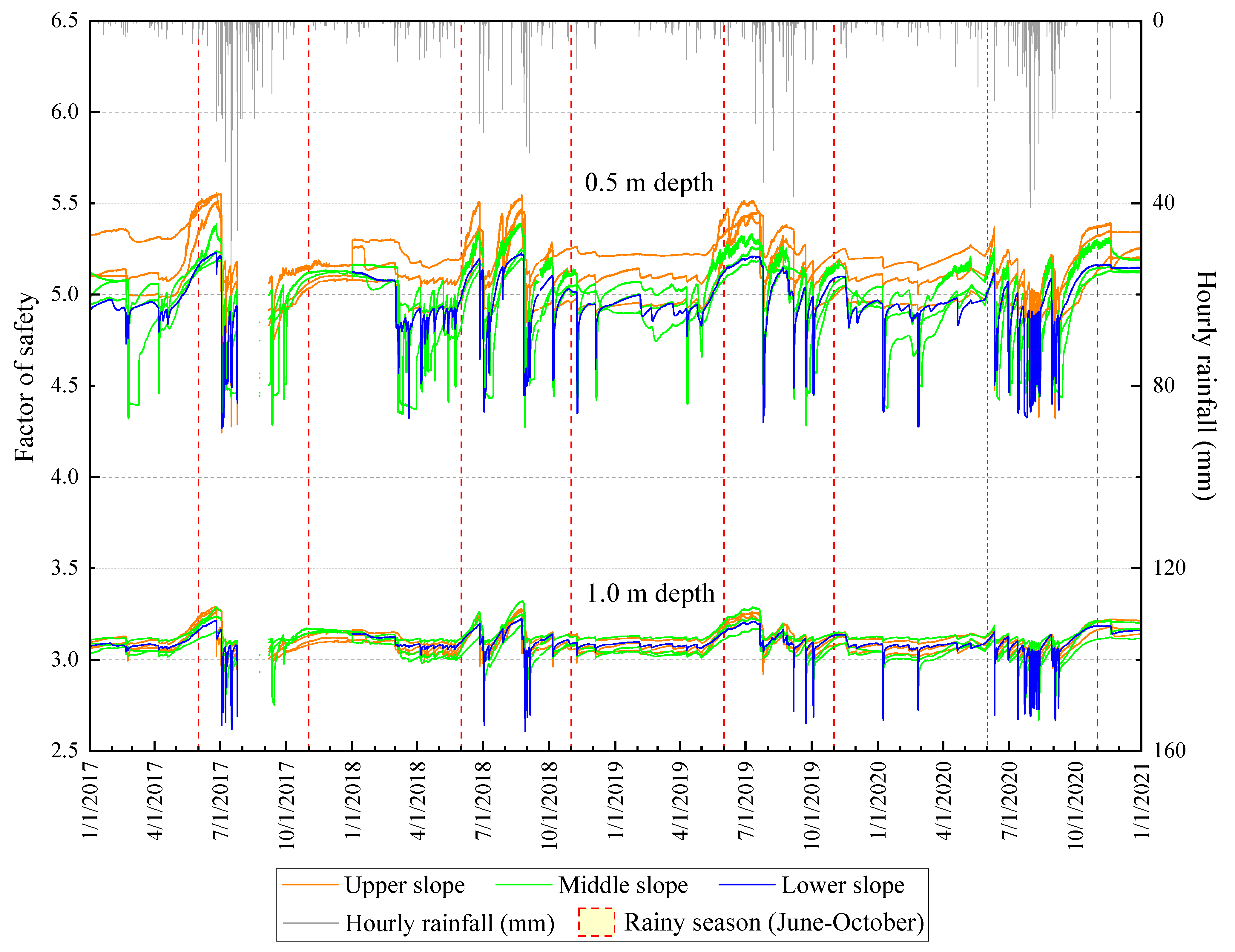

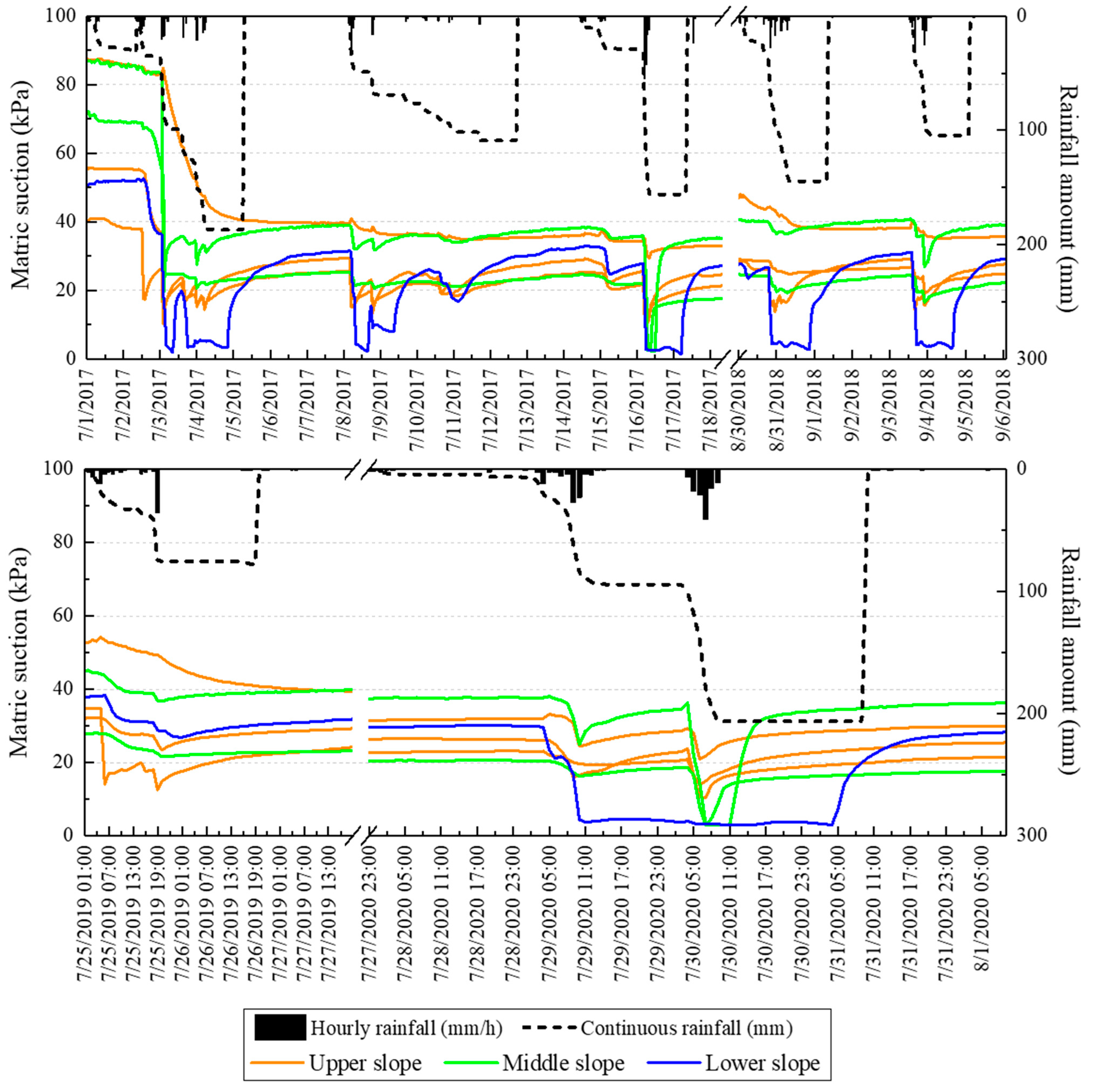
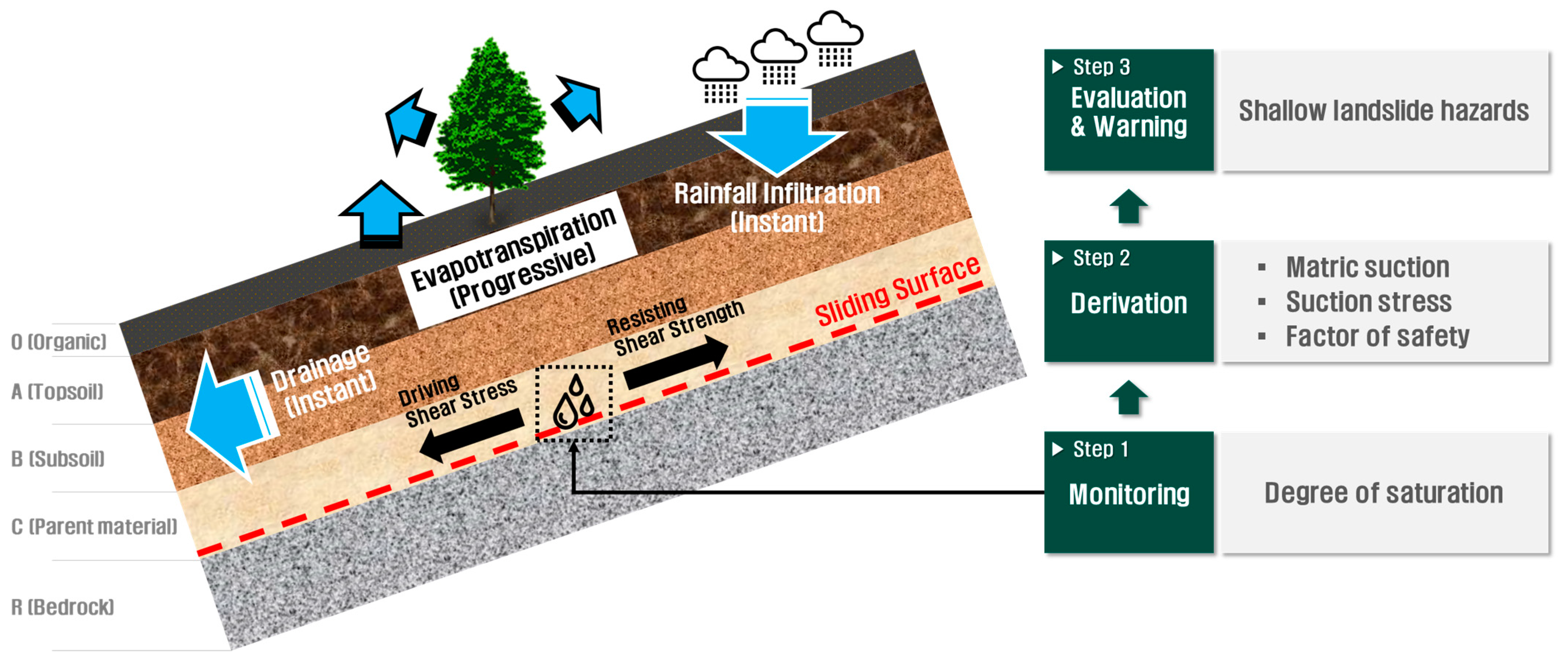
| Parameter | Symbol and Unit | Value |
|---|---|---|
| Dry Unit Weight | γd (g/cm3) | 1.34 |
| Effective Cohesion | c′ (t/m2) | 0.94 |
| Effective Internal Friction Angle | φ′ (°) | 28 |
| Test Condition | α | n | m |
|---|---|---|---|
| Drying Process | 0.145 | 1.99 | 0.497 |
| Wetting Process | 0.245 | 1.712 | 0.416 |
Publisher’s Note: MDPI stays neutral with regard to jurisdictional claims in published maps and institutional affiliations. |
© 2021 by the authors. Licensee MDPI, Basel, Switzerland. This article is an open access article distributed under the terms and conditions of the Creative Commons Attribution (CC BY) license (https://creativecommons.org/licenses/by/4.0/).
Share and Cite
Kim, K.-S.; Jeong, S.-W.; Song, Y.-S.; Kim, M.; Park, J.-Y. Four-Year Monitoring Study of Shallow Landslide Hazards Based on Hydrological Measurements in a Weathered Granite Soil Slope in South Korea. Water 2021, 13, 2330. https://doi.org/10.3390/w13172330
Kim K-S, Jeong S-W, Song Y-S, Kim M, Park J-Y. Four-Year Monitoring Study of Shallow Landslide Hazards Based on Hydrological Measurements in a Weathered Granite Soil Slope in South Korea. Water. 2021; 13(17):2330. https://doi.org/10.3390/w13172330
Chicago/Turabian StyleKim, Kyeong-Su, Sueng-Won Jeong, Young-Suk Song, Minseok Kim, and Joon-Young Park. 2021. "Four-Year Monitoring Study of Shallow Landslide Hazards Based on Hydrological Measurements in a Weathered Granite Soil Slope in South Korea" Water 13, no. 17: 2330. https://doi.org/10.3390/w13172330
APA StyleKim, K.-S., Jeong, S.-W., Song, Y.-S., Kim, M., & Park, J.-Y. (2021). Four-Year Monitoring Study of Shallow Landslide Hazards Based on Hydrological Measurements in a Weathered Granite Soil Slope in South Korea. Water, 13(17), 2330. https://doi.org/10.3390/w13172330







